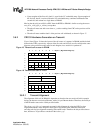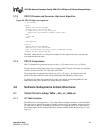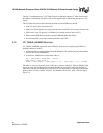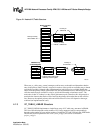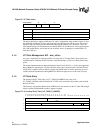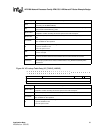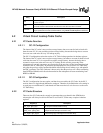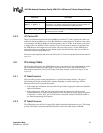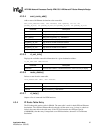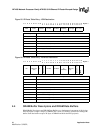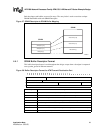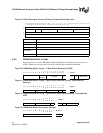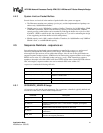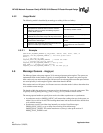
IXP1200 Network Processor Family ATM OC-3/12/Ethernet IP Router Example Design
Application Note 35
Modified on: 3/20/02,
4.2.3 VC Cache API
There is no interaction between the StrongARM core and the VC Cache. In particular, there is no
method for the StrongARM core to force the ATM Receive microengine to invalidate cache entries
to synchronize with StrongARM core initiated updates to the VC Table. If the design is enhanced
to support SVCs in addition to PVCs, then the Core will need such an interface to guarantee that
the ATM Receive microengine does not operate with stale cache entries. (As the ATM Receive
microengine does not consume any inter-thread signals after initialization, they are available for
interaction with the StrongARM core.)
The macros that implement the microcode API to the VC Cache are implemented and described in
atm_rx.uc.
4.3 IP Lookup Table
The IP lookup table used in the ATM/Ethernet router is an extension of the implementation used in
the homogeneous Ethernet example designs. The same table is used to store both ATM and
Ethernet port destinations. The two IP Lookup Table Entry formats are shown in Figure 25 and
Figure 26.
4.3.1 IP Table Function
The route table provides routing information for a given IP destination address. The type of
information provided by the table differs slightly depending on which technology (ATM or
Ethernet) will be used to transmit the packet.
• If the output port is Ethernet, the route table will provide the output port number and the MAC
address information.
• If the output port is ATM, the route table will provide the output queue (In the current
implementation this is a physical port identifier, future designs may use this queue designation
to represent a "virtual" port), the VCI/VPI for the connection, and the LLC/SNAP header to
use when encapsulating the IP packet.
4.3.2 IP Table Structure
The ATM project uses the Trie5 Longest Prefix Match algorithm implemented in ip.uc. The lookup
portion of the table is maintained in SRAM with the actual route table entries in DRAM.
@vc_crc0...@vc_crc3 Local working copy of the CRC syndrome in the VC Table Entry.
@data11_0...@data11_3
Holds the last four bytes of the previous cell in the VC table, so the
microengine can combine it with the first four bytes of the subsequent cell
and perform a single 8-byte DRAM write including them both.
@vc_address...@vc_address3
Records the address in SRAM where the backing VC Table Entry came
from, so that it is not necessary to re-compute it when it is time to write the
updated entry back to SRAM.
Register(s) Description



